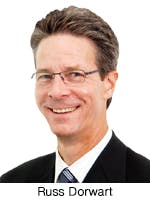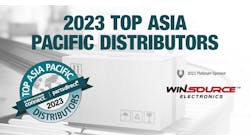Companies in the electronic components supply channel are calling for slow but steady growth for the remainder of 2015, as weaker business conditions across a range of end markets cast a shadow over the strong growth in the channel last year. The conditions have many companies focused on targeting new markets, looking for acquisitions, and expanding their geographic reach.
Manufacturer and distributor executives attending the 2015 Electronics Distribution Show (EDS) in Las Vegas—held in early May—agreed that the electronic components channel is likely to see lower sales growth this year than last; but many are hopeful for an upturn in the 2016-2017 time frame, as some manufacturing returns to North America, the Internet of Things market heats up, and the sluggish oil and gas market improves.
“In general, 2014 felt very health,” explained Dave Doherty, executive vice president of operations for large catalog distributor Digi-Key. “We will see less growth as reported in U.S. dollars this year … Now, as an industry, [conditions have been] remarkably stable.”
Digi-Key’s global sales grew 13% in 2014, and although the company is predicting double-digit gains again this year, they are expected to be lower, Doherty said. He emphasizes ongoing market stability, though, and points to a spirit of innovation that is driving business worldwide, as well as pockets of regional strength. He says China is “exploding” for Digi-Key, for instance; the distributor has focused on building its modest business in China over the last few years and expects 30% growth in the region this year. As for innovation, Doherty says it’s happening everywhere.
“Germany is a big market [for innovation],” he explains, pointing to Digi-Key’s design engineering customer focus. “But we see just as much innovation coming out of Eastern Europe, too. It’s happening everywhere. No region has cornered the market on this.”
Global emphasis on STEM (science, engineering, technology, and math) programs along with a focus on robotics is also helping to drive innovation in electronics, which is always a boon to electronic components suppliers.
“There is just so much innovation driving business across all segments,” Doherty emphasizes. “Small, nimble companies, especially, will continue to innovate.”
Moderating Growth
Although a culture of innovation is helping to keep business on the upswing, slowing conditions in some industries are combining to equal moderating growth across the electronic components sector. Many distributors point to a slowdown in oil and gas and pent-up demand in industrial markets that has yet to be realized.
Distributor TTI, Inc. is calling for lower growth than last year, predicting a roughly 6% increase in sales for 2015. Those figures are in line with other distributors of electronic components, who cited a slow start to the year as a cause for concern. TTI’s sister companies, Mouser Electronics and Sager Electronics, are calling for low double-digit growth, however. Mouser, a large catalog house like Digi-Key, is predicting a 12% sales increase while specialty distributor Sager is calling for 10% growth. Michael Knight, TTI’s senior vice president, Americas, points to the flattening out of the electronics industry, which had long been accustomed to explosive growth driven by the introduction of new technologies.
“What [the industry] has struggled with the last 10 years or so is that there hasn’t been a lot of change,” Knight explains. “Conditions have flattened out. Consequently, that ‘hot new killer app’ has been much slower to materialize. That wasn’t the case in ‘80s and ‘90s.”
Russ Dorwart, president and chief operating officer of specialty connector distributor PEI-Genesis, agrees, and points to generally slower conditions across the board. He predicts 5% to 6% growth for PEI-Genesis this year, pointing to stronger growth in Europe than North America. The distributor’s newest venture is a facility in China, opened this spring, that is “off to a great start” Dorwart reported in early May. The distribution and connector fabrication facility—which mirrors PEI’s facilities in South Bend, Indiana, and Southampton, United Kingdom—is focused on supplying local customers in a range of industries, including solar, oil and gas, railway, and mass transit. The company expects the new division to produce about $10 million in sales this year.
In addition to geographic expansion, PEI-Genesis is focused on growing through acquisition over the next few years.
“Things have leveled off early in 2015. There’s been lackluster growth across the board,” Dorwart said of the industry overall. The distributor’s new acquisition strategy will focus on adding business that “makes sense” for PEI-Genesis and its specialty focus.
Allied Electronics is predicting slower growth this year as well, but company President Scott McLendon agrees with others that Europe is showing stronger growth than it has in recent years. Allied is predicting double-digit growth in Europe this year, with high single-digit growth expected for the company overall. In North America, McLendon says pent-up demand in industrial markets will fuel capital equipment spending in the next couple of years. As for current growth markets, he points to water/wastewater, food and beverage, and the industrial IoT market—particularly the opportunity it presents for factory automation, an Allied specialty.
“There are a few long-term economic headwinds challenging the industrial market,” he said, pointing to the strong U.S. dollar, in particular. “I don’t think that will subside this year. But long-term, there is about $65 billion in [U.S. factory] automation that needs to re-fresh, and that will fuel capital equipment spending growth.”
Connectivity Spells Opportunity
Avnet’s Ed Smith, president of the distributor’s Electronics Marketing Americas division, agrees that a mature market is taking its toll on distributors. But that just means companies must adapt and change with the times. Smith points to the embedded and IoT markets as good opportunities ahead for Avnet, due to its ability to go from “the Fitbit to the enterprise,” as he describes it. Avnet’s work across the technology spectrum means that it not only supplies electronic components to customers building new products, but it also provides embedded technology solutions and consulting services through its embedded services and Rorke Global Solutions businesses.
Despite the challenges, Smith is calling for a better economic outlook than last year for Avnet EM Americas, noting that sensors and wearable technology is driving growth. He said he also expects aerospace and commercial aviation markets to fare better over the next few years.
TTI’s Knight agrees that there are bright spots ahead for the electronics industry.
“I think our best days are still ahead of us, and part of that is because there are an awful lot of things happening now–and anytime there’s change, there’s opportunity,” he says, emphasizing the IoT/connectivity trend in general. “The Internet is basically a power grid for information. What I think is more relevant, and can be monetized, is the area of machine-to-machine technology. This is not new, but it has exploded. It’s enabled by the IoT idea, but also by low-energy devices, near-field communication, and other wireless protocols.
“What I find fascinating is everything connecting and working together symbiotically to deliver a better experience, with more features, and really starting to impact a better quality of life. That is very exciting for our industry.”
Gil Zaharoni, chief executive officer of specialty distributor Symmetry Electronics, sees similar potential in an “all things connected” world. Symmetry posted a strong first quarter, and Zaharoni said he expects that to continue for the remainder of the year, helped by the company’s focus on wireless technology.
“The product we’re selling is just hot,” he explains, pointing to the company’s secondary focus on video technologies, as well. He says medical, industrial, security, and digital signage are particularly strong markets.
“I think [connectivity/IoT] is going to be huge, because it touches every application,” he adds. “It’s everywhere, and it’s all anyone talks about. And we’re set up to be right there, capturing that business.”
Karim Yasmine, corporate vice president, strategic supplier development, for large distributor Future Electronics, agrees that the IoT market holds great promise for components suppliers. He points to Future’s investment in this area, which began seven to eight years ago and included a customer identification program, the building of a support network, and a beefing up of its line card—especially in wireless technology products.
“Most of our vendors that are strong wireless vendors count on us to service and support [IoT] customers,” Yasmine explains. “And we see those segments growing. The IoT piece is greater than I think people realize.”
Yasmine says Future followed 2014 with a strong first quarter, and that Q2 was off to a good start as well, as of early May. All in all, he says he expects 2015 to shape up well for the Montreal-based global distributor.
“We want more than two times industry growth,” he says. “We expect a strong year this year.”










